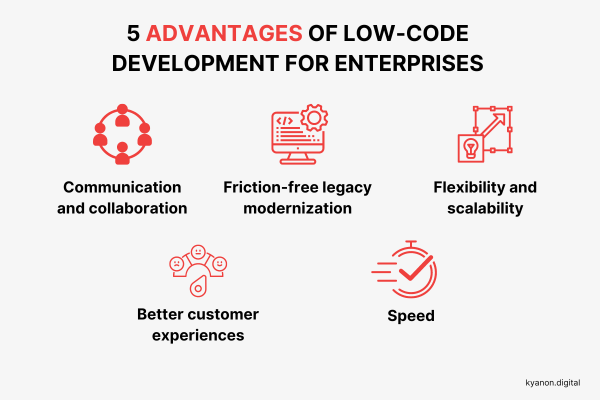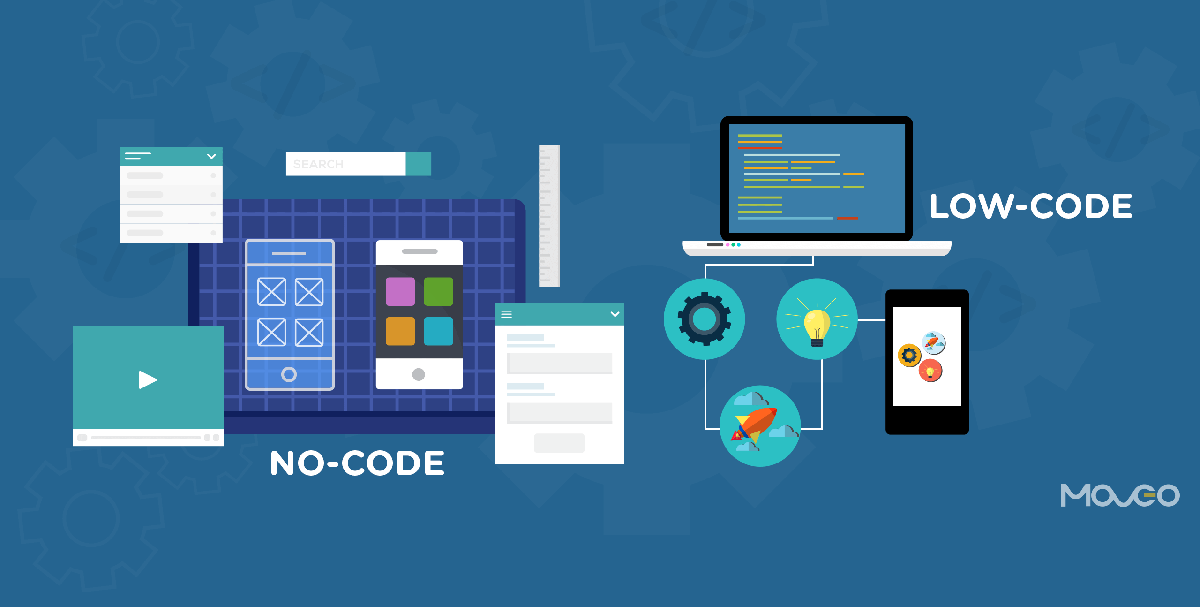Great Reasons On Deciding On Low-Code Platform Info
Great Reasons On Deciding On Low-Code Platform Info
Blog Article
The Ease Of Use Of Low-Code Apps Is Among The Major Benefits.
Low-code apps improve accessibility by non-developers (often referred to as "citizen-developers") due to a few key factors.
Drag-and -Drop Builders. Low-code platforms come with drag-and -drop interfaces. This provides non-programmers with the ability to build applications using visuals, without having to write code. This allows development to be easier for people with technical backgrounds.
WYSIWYG Editors: "What You See Is What You get" editors allow users to create interfaces and workflows in an approach that is similar to the final product, making it simpler to understand and use.
Simple Workflow and Logic Design:
Visual Workflow modeling: Users design business flows and application logic using visual flowcharts. The models are more intuitive to use than conventional codes.
Pre-built Logic components Low-code platforms contain logic components that have been already built (e.g. conditional statements and loops) and can be easily customized which eliminates the need for complex programming.
Reusable Components and Templates
Library of pre-built templates Many low-code platforms offer a library of templates for common applications, enabling non-developers to start with a solid foundation to customize as needed.
Reusable Widgets and Modules Users can make use of modular and reusable widgets, streamlining the creation process and eliminating the need for in-depth technical knowledge.
Tutorials for Guided Development and Guided Development:
Step-by-Step Guides: Platforms often provide a development path that is guided, tutorials, and on-screen tips to assist non-developers in building applications.
Interactive Tutorials: Interactive and hands-on tutorials let users learn by doing. They gain confidence by making use of the platform.
Integration with tools already in use:
seamless integration: Low-code platform are designed to integrate seamlessly with the existing business tools, systems, as well as software (e.g. ERP or CRM). This allows non-developers who do not have a background in programming to build applications that can work seamlessly with their current workflows.
APIs/Connectors: These APIs/Connectors allow non-developers to connect their apps to external services.
Collaboration Features:
Team Collaboration: Real-time collaboration, shared workspaces and shared workspaces allow business analysts, non-developers, and other stakeholder groups to effectively work alongside professional developers.
Access control based on Role: Non developers can be assigned roles with the appropriate access levels. This lets them contribute to development without compromising security or functionality.
Automated Testing and Debugging:
Test Tools Included: A lot of low-code platforms have built-in debugging and testing tools. These tools automate the process, making it easier for non-developers to ensure their applications are working correctly.
Error-highlighting: The platform provides information on issues and suggestions to guide non-developers.
In general, low-code app development can democratize development. This is an important advantage for non-developers. Low-code platforms allow business users to participate actively in the development and maintenance of apps by offering visual tools and a guided experience. This bridges the gap between technical implementation and business requirements. Follow the top this site about Low-code Platform for application development for site tips including ms azure sql, push alerts, multiplatform mobile app development, develop web application, jdbc server, app development platform, develop cross platform mobile app, microsoft azure sql, app modernisation, stored sql procedures and more.
Low-Code Development's Cost-Effectiveness Is Among The Major Advantages.
The low-code approach to application development is a cost-effective solution with many benefits. It's an excellent choice for companies who want to make the most of their budgets and deliver quality apps. Here are the major benefits:
Lower Coding Requirements: Low Coding platforms remove the need to code manually, saving developers both time as well as money. This results in lower costs of labor.
We require less developer resources: Low-code development requires shorter time, and it is easier. This means fewer developers are required. It can reduce the cost of hiring and staffing.
Faster time to market:
Accelerated Development Cycle Visual development tools and pre-built components offered by low-code platforms facilitate rapid application development, which allows companies to get their products on market faster. This could lead to quicker revenue generation and better position in the marketplace.
Rapid prototyping: By creating rapid prototypes and testing them quickly companies can decrease the time they spend in the development stage and enable faster iterations on the basis of user feedback.
Lower Maintenance Costs
Due to their modular structure and common components, low-code platforms typically simplify the maintenance of applications. This helps reduce the cost of ongoing maintenance.
Automated Updates: Many low-code platforms handle updates and patches automatically, ensuring applications remain secure and up-to date without needing extensive manual intervention.
Efficient Resource Utilization:
Contributions from non-developers: Low-code platforms enable both developers and business users to participate in the process of development. This democratization enables enterprises to profit from the expertise of a broad spectrum of employees.
IT Departments can Focus on Strategic Initiatives instead of getting overwhelmed by the daily work, IT departments can focus their energies on strategic initiatives that increase the efficiency and productivity of their departments.
Modular Pricing Models that Scale:
Subscription-Based Price: Many low-code platforms have flexible subscription-based pricing that scales according to use. This allows business to align spending with actual needs and growth while avoiding significant up-front costs.
Pay-as-you-go options - Some platforms allow businesses to pay only for the services they use. This is particularly useful for startups or small companies with limited funds.
Reduce the cost of Third-Party software:
Built-in Functionalities: Low code platforms are equipped with a wide range of built-in features and integrations, which make it less necessary to use third-party tools and software. Subscription fees and licensing charges are also reduced.
Pre-Built Integrates by integrating well-known services and systems, you can save time and money by not having the necessity of creating custom integrations.
Improved ROI:
A faster return on investment: A combination of rapid development and lower costs, coupled with an increased time to market can help businesses get greater return on their investment.
Increased Agility: Businesses are able to quickly adjust to changes in the market and the changing needs of customers. This lets them stay relevant and capitalize on opportunities that come up.
Lower Cost of Training:
User-Friendly Interfaces: The intuitive interfaces and user-friendly functions of low-code platforms reduce the learning curve thereby eliminating the need for intensive training.
Accessible Resources A lot of low-code platforms provide extensive instructional materials, tutorials and support for community members, thereby cutting the need for formal training and the associated cost.
Streamlined collaboration:
Improved Collaboration Tools: The integration of collaboration tools allows improved communication between team members and a reduction in project overhead.
Unified Development Environment. An unified development platform can help reduce costs and streamline workflows through reducing the complexities of managing various tools.
Low-code development is cost effective because it lowers maintenance and development expenses. It also speeds up time to market as well as optimizes the use of resources. Pricing models are flexible. These aspects provide significant financial benefits to business and make low-code an attractive option for businesses seeking to maximize their budgets and achieve robust, scalable, high-quality apps. Read the most popular Enterprise application development with Low-code Platform for site tips including mobile app development platforms, paas service, low code development platforms, app modernisation, push alerts, mobile app development platforms, low code platforms, jdbc server, push notifications, develop web app and more.
Advantages Of Low-Code Application Development In Terms Of Collaboration And Workflow
It's a great option for companies looking to boost team productivity by streamlining processes and improving collaboration. Here are a few of the advantages.
Unified Development Environment : Low-code platforms offer a unified, single environment where team members can collaborate effectively including business analysts, designers and other stakeholders. This helps reduce the number of silos, as well as improves communication.
Visual Development Tools - The drag and drop visual nature of low code platforms allows people who are not technical to participate easily in the process. This ensures that all business requirements are identified and accurately implemented.
Communication Enhancement:
Real-Time Collaborative Features: Many platforms using low-code provide real-time collaboration features, such as simultaneous editing, comments and immediate feedback. These tools facilitate collaboration and cut down discussing back and forth.
Shared Workspaces: Teams can work together in shared workspaces, which allows them to view, edit, and discuss project components, ensuring everyone is on the same page and working towards common goals.
The management of workflows has been simplified
Project management tools that are built-in Low-code platforms typically come with project management tools integrated which allow teams to plan, track and manage their projects. This includes task assignment, progress monitoring, and management of deadlines.
Workflow Automation: Automating repetitive tasks and workflows can help reduce manual errors and effort and allow employees to focus on strategic activities while improving efficiency.
More Rapid Iteration:
Rapid prototyping. Low-code platforms allow rapid prototyping. This allows feedback to be rapidly incorporated, and improvements can be implemented.
Agile Development Support: Support for agile methodologies lets teams work in sprints, continuously providing small amounts of functionality. This makes it easier to respond to changing requirements.
Accessibility for non-developers:
Citizens Development: Lowcode platforms enable users of business applications (citizen developers) to develop as well as modify and maintain applications with no programming expertise. This reduces the burden on IT as well as development teams and allows for quicker response to business requirements.
Training and Onboarding - Simple interfaces, extensive training materials, and user-friendly interfaces make it simple for new team members get up to speed and enhance the overall team collaboration.
Centralized Knowledge Sharing and Documentation:
Documentation integrated: Low-code platform features often permit you to create and manage documents on the platform. All information about your project is centrally accessible and easy to access.
Knowledge Repositories: Teams are able to create and keep knowledge repositories, which include best practices, templates and reusable components, facilitating knowledge sharing and reducing duplicate work.
Consistency Standards, Standardization and Consistency:
Standardized Components. Utilizing pre-built standard components provides uniformity throughout all software. This helps team members be able to work with the various aspects of their projects.
Governance and Compliance: The built-in governance frameworks ensure that all development follows organizational standards and regulatory requirements, reducing the risk of non-compliance and making sure that the applications are in compliance with the quality standards.
Feedback loops:
Integrated Feedback Systems: Low code platforms have integrated feedback systems that allow users to provide feedback about the application. The feedback could later be utilized in the creation of those applications.
Continuous Improvement: The ability to quickly iterate and then deploy changes as a result of feedback allows for constant improvement of software. They are in close alignment to the requirements of users as well as business goals.
Visualization of Reporting
Real-time Analytics: In-built analytics and reports provide real-time information about project performance, user interactions and the progress. Data-driven decision-making is possible.
Visual Workflow Maps: Software to map workflows or processes are helpful for teams to comprehend their processes. They can also identify bottlenecks and areas that require improvement.
The advantages of low-code development in terms of workflow and collaboration lie in its capacity to bring together diverse teams, streamline communication, and streamline processes. This leads to a more flexible, collaborative, and efficient developing environment that produces higher-quality apps.